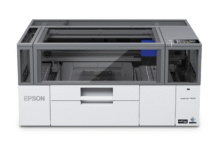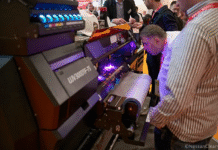Mumbai-based Venus Infotech organized an open house on 14 December at its Girgaon office to promote digital direct to garment (DTG) printing, primarily on cotton t-shirts and showcased Epson’s SureColor SC-F2130 DTG printer. The event was attended by t-shirt printers, printing students, blank t-shirt manufacturers, who plant to venture into t-shirt printing, and designers.
“The idea behind this open house was to promote the concept of DTG printing, especially on cotton t-shirts. We got a great response and had close to 50 visitors during the one-day open house. We tried to inform the visitors about the technology as well as cost structure involved,” says Hemanshu Desai, founder of Venus Infotech.
Desai says that t-shirt printers are still misinformed about the costs involved in DTG printing. “There is an impression that costs are higher for DTG as compared to tradition screen printing. But the fact is that DTG printing has different dynamics,” says Desai.
DTG printing technology is useful when one wants customized printing, or have a short print run, or you want to keep minimum inventory, he says.
“DTG printing makes a lot of sense when you are doing business online, and you can fulfill orders of one or two t-shirts. Also, these days, fashions and designs change every few months, and with DTG, you can easily adapt as you do not have to print large quantities. And since you do not have to maintain large inventories, you save on inventory costs. There are many advantages as compared to tradition printing technologies such as screen printing,” Desai argues.
DTG concept gradually catching up
Although DTC technology is in its infancy in India, the concept is gradually catching up while the market for printed t-shirts is gaining a rapid pace.
“The nature of the printed t-shirt market is changing as customers these days want a lot of personalized t-shirts. For example, when a group of friends go on an international holiday, they get personalized t-shirts printed. DTG printing can come in handy here. Also, the booming eCommerce market is helping shoot the demand for personalized t-shirts. We have seen a good demand for the Epson DTG printer, SureColor SC-F2130, in the last 8-9 months,” says Desai.
The SureColor SC-F2130 DTG printer is equipped with PrecisionCore printhead technology, teamed with an automated maintenance design. It prints up to 25-mm thick t-shirts, has advanced automated maintenance design and Oeko-Tex Eco Passport certification, and has easy to use garment creator software. The printer prints directly onto fabric products with Epson UltraChrome DG ink to achieve accurate and bright colors. The ink has been specially formulated with high-dispersion ink technology that helps reduce white ink sedimentation to give it a very natural white color.
“The Epson brand is a well-respected one, and we expect the printers to continue to be well accepted in the Indian market,” Desai concludes.
















